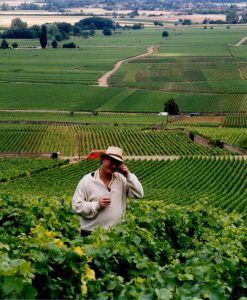In our last issue, we discussed the pleasures of walking through vineyards and also noted that most farmers aren’t crazy about the idea of tourists doing so. Here are various ways to get near or into a vineyard, some more official than others.
One way is to visit a winery that has set aside a few rows of vines for the express purpose of access by visitors. You’re most likely to find these near California wineries. Grgich Hills in Rutherford in Napa Valley and Dry Creek Vineyards in the eponymous region in Sonoma County are two examples of wineries that have these model vineyards. One of the advantages is that they have different sorts of red and white grapes growing right next to each other, so you can compare them. Of course, the best time to do so is in August and September, when there are grapes hanging from the vines.
The best way to learn about the vineyards is to take a winery tour that includes a walk though the vines. In fact, some wineries only offer tastings if you take a tour and build a walk among the vines into the tour. Stags’ Leap and Chappelet on Pritchard Hill, both in Napa Valley, are among those that arrange their tastings that way. There are some plusses and minuses, though. A guided vineyard tour offers particular advantage if your guide is a well-versed educator. You can get some valuable lessons by seeing why grapes grown in this kind of soil, near that water source, produce grapes that are used to make the wine you just tasted. However, you need to plan more time at the winery and be ready to hear the sales pitch at the end of the tour.
Weather can be a factor, too. We once took a tour at Chappelet on a brutally cold day in December (yes, it happens) and a few sips of Sauvignon Blanc among the barren vines was not enough to warm us up. We took another one in fall and it was the most beautiful view of the vineyard when the leaves of the vines had turned color.
In a Burgundy vineyard.
For the most part, American growers fence off their vineyards. The same can be said of producers in Bordeaux. But in Burgundy it’s different. The reason is a bit complicated, tied up in the inheritance practices of centuries gone by in that region. A person’s estate was divided among all of his, or occasionally her, children. As a result, each child received a few rows of vines in this vineyard and another couple in that one in the next town. Today, even in the most famous Burgundy vineyards such as Chambertin or La Romanée, there are many owners of each parcel of land. The vineyards can’t be fenced in because too many people have to have access to them. And so tourists are welcome (respectfully, please) to walk among the rows.
Better yet, you can take a picnic and enjoy it alongside a vineyard, which we have done many times. Once we had stopped at a charcuterie in Nuit St. Georges and then picked up a bottle in a wine store and then headed up the road. We found a quiet spot next to a vineyard owned by a Monsieur Dugat and settled ourselves in for lunch. (Don’t try doing that in Napa/Noma!) At that point M. Dugat happened to walk by. We were afraid he would ask us to leave, but he just eyed what we were eating and in particular wanted to know what we were drinking. “Oh, just a picnic”, Lucie replied in French. The farmer eyed our wine bottle and saw that we had chosen a nice premier cru so he said, “Quel pique-nique!” (What a picnic!) and went on his way.

